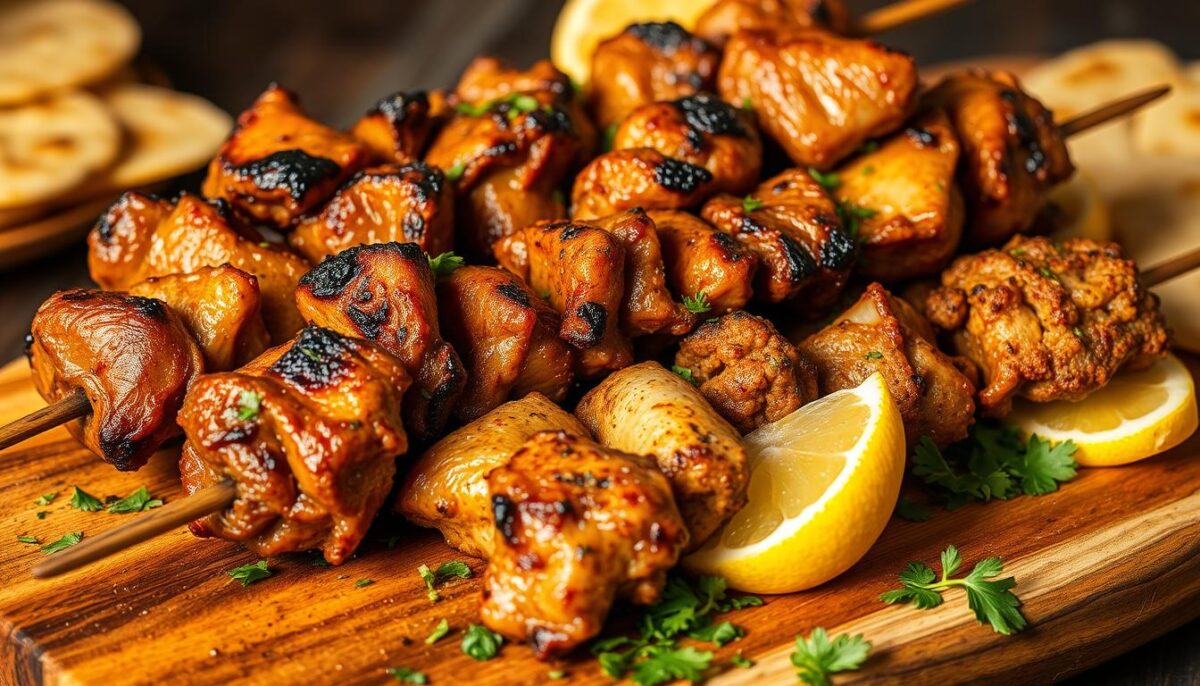
Belgian Bites: How to Recreate Waffles, Stews, and Beer Pairings
May 2, 2025
How to Make Syrian Comfort Food: Kibbeh, Yalanji, and More
May 2, 2025I still remember the first time I inhaled the warm, buttery aroma of golden saffron steaming over fluffy grains. It was at a friend’s dinner party, where every bite felt like a story—tender meat glazed with charred edges, spices humming in harmony. That meal didn’t just fill my plate; it sparked a craving to recreate those flavors in my own kitchen.
Years later, I stood at my stove, nervously adjusting skewers over flickering flames. My hands trembled as I mixed saffron threads with ice cubes, watching the water blush orange-red. But when that first perfect kebab emerged—juicy, fragrant, and layered with garlic and onion—I realized how these dishes weave history into every bite. It’s not just food; it’s heirloom craftsmanship.
What makes these recipes sing? It starts with patience. Marinating meat for hours in turmeric and citrus. Letting basmati grains steam until they form a crispy crust. Even the skewer matters—how you shape it affects texture. And saffron? That crimson thread ties everything together, turning simple ingredients into something extraordinary.
Key Takeaways
- Traditional flavors rely on balanced spices like saffron and turmeric
- Quality basmati and fresh meat are non-negotiable for authenticity
- Marination time deeply impacts tenderness and flavor depth
- Proper tools, like metal skewers, ensure even grilling
- Step-by-step guidance simplifies complex techniques
Embracing the Heritage of Iranian Cuisine
My kitchen counter once held a tiny vial of saffron threads—a gift from a chef who told me, “This isn’t seasoning. It’s sunlight captured in spice form.” That moment reshaped how I viewed every pinch of turmeric or grind of black pepper. These ingredients carry centuries of trade routes, family traditions, and quiet kitchen wisdom.
The Alchemy of Authentic Spices
What makes saffron irreplaceable? It’s not just the color or aroma. It’s the care—hand-picked stigmas dried under specific conditions. I learned to bloom it in warm water, releasing its golden hue. Turmeric powder and fresh garlic became my allies, adding earthy depth to marinades. Even salt matters: coarse grains rubbed into meat create texture, while fine crystals meld flavors.
From Curiosity to Cultural Connection
My first attempt at traditional recipes felt like decoding hieroglyphs. Why grate onion into the marinade? Turns out, its enzymes tenderize meat naturally. I timed every step—30 minutes for spice blending, 2 hours for marinating. The bowl I used wasn’t just a container; it became a bridge between my modern kitchen and ancient methods.
Now, when I measure saffron threads, I think of the hands that harvested them. When I layer spices, I hear generations whispering, “This is how we’ve always done it.” And that’s the magic—transforming butter, water, and patience into something that tastes like history.
Step-by-Step Guide to Iranian persian rice kebabs
Mastering these grilled specialties requires equal parts precision and passion. Let me walk you through the techniques that transformed my kitchen experiments into crowd-pleasing meals.

Preparing the Meat and Marinade for Perfection
Start with 2 pounds of fresh lamb or beef. Grate one large onion into a bowl, then squeeze out the juice—this tenderizes without overpowering. Combine 1 teaspoon each of turmeric and black pepper, plus ½ cup olive oil. Massage this into the meat until glossy.
Let it rest 4-5 hours. I set a timer—anything less won’t develop the flavor depth. The marinade should cling to your fingers, signaling it’s ready.
Skewering, Grilling, and Achieving Juicy Results
Metal skewers work best. Shape meat into 1-inch cylinders—too thick, they burn; too thin, they dry out. Leave ½-inch space between pieces for even heat.
Grill 4 minutes per side, basting with melted butter. My trick? Hold skewers 6 inches above flames. The sizzle should sound like steady rain, not a thunderstorm.
| Step | Time | Key Tip |
|---|---|---|
| Marinating | 4-5 hours | Use glass bowl |
| Skewering | 10 minutes | Chill meat first |
| Grilling | 8 minutes total | Baste every 2 minutes |
Serve immediately with flatbread and grilled tomatoes. The first bite should release a burst of garlic and citrus—proof you’ve balanced spices and technique perfectly.
Authentic Rice Recipes and Flavorful Sides
I once ruined three pots of rice before discovering the golden rule: every grain deserves patience. The moment I lifted the lid on perfectly steamed basmati—each strand separate yet tender—I understood why this dish anchors countless meals.
Secrets to Perfect Basmati and Saffron Rice
Start with 2 cups of quality basmati. Rinse until the water runs clear—this removes excess starch. Soak for 30 minutes while blooming saffron in 3 tablespoons of warm water. Drain the rice, then boil with 4 cups of salted water for 6 minutes.
The magic happens during the dum phase. Layer the parboiled rice with melted butter and saffron water in a heavy pot. Cover with a towel-trapped lid to lock in steam. Cook on low heat for 45 minutes—no peeking!
Complementary Vegetables and Accompaniments
While the rice steams, grill cherry tomatoes brushed with olive oil and garlic. Their charred sweetness balances the saffron’s floral notes. For crunch, toss cucumbers with mint and lime—a 5-minute salad that brightens rich flavors.
| Component | Prep Time | Flavor Tip |
|---|---|---|
| Basmati Rice | 1.5 hours | Add cardamom pods to boiling water |
| Grilled Tomatoes | 10 minutes | Finish with flaky sea salt |
| Cucumber Salad | 7 minutes | Use Persian cucumbers for crispness |
My favorite trick? Stir fried onions into the rice’s golden crust at the bottom of the pot. It’s like uncovering edible treasure—crispy, caramelized, and utterly irresistible.
Conclusion
Creating memorable meals starts with respecting the clock and the cutting board. Through trial and error, I’ve learned that time transforms tough cuts into tender masterpieces—whether marinating meat for hours or letting saffron bloom in warm water. Every step, from grating onion to threading skewers, builds layers of flavor.
Don’t rush the process. Those 45 minutes for rice to steam? They’re non-negotiable. The sizzle of oil on grill grates? It’s your timer. Even the bowl you choose matters—glass keeps marinades fresh, while metal conducts heat evenly.
Balance is key. Juicy meat needs saffron-kissed grains. Charred tomatoes crave crisp cucumber salad. And always—always—save that golden crust at the bottom of the rice pot. It’s proof you’ve honored the craft.
Now it’s your turn. Grab a skewer, fire up the grill, and let spices guide you. Share your twists in the comments—I’d love to hear how these traditions inspire your kitchen.
FAQ
How long should I marinate the meat for juicy kebabs?
I recommend marinating for at least 2 hours, but overnight works best! The yogurt, onion, and spices tenderize the meat while locking in moisture. Don’t skip the saffron—it adds that golden hue and floral aroma.
Can I use regular rice instead of basmati?
While basmati’s fragrance and fluffy texture are ideal, you *can* substitute long-grain rice in a pinch. Rinse it thoroughly and add a pinch of turmeric for color. Trust me—the nutty basmati flavor is worth seeking out!
What’s the trick to getting grill marks without drying out the kebabs?
High heat and patience! Oil the grates well, and don’t move the skewers too soon. I rotate them just once to get those crisp lines. Basting with melted butter or oil keeps everything succulent.
Do I need a special spice blend for authentic flavor?
Keep it simple—fresh garlic, black pepper, and a touch of sumac or lemon juice work wonders. If you’re missing a spice, focus on balancing savory and tangy notes. Saffron threads steeped in warm water elevate everything!
Can I make vegetarian versions of these dishes?
Absolutely! Grilled halloumi or marinated mushrooms skewer beautifully. Pair them with saffron-infused rice and charred tomatoes. Even meat lovers ask me for seconds of these veggie options.
How do I prevent the rice from sticking to the pot?
Rinse the grains until the water runs clear, then use a heavy-bottomed pot. Let the bottom layer crisp into *tahdig*—the golden crust everyone fights over. A towel under the lid traps steam for perfectly separated grains.



